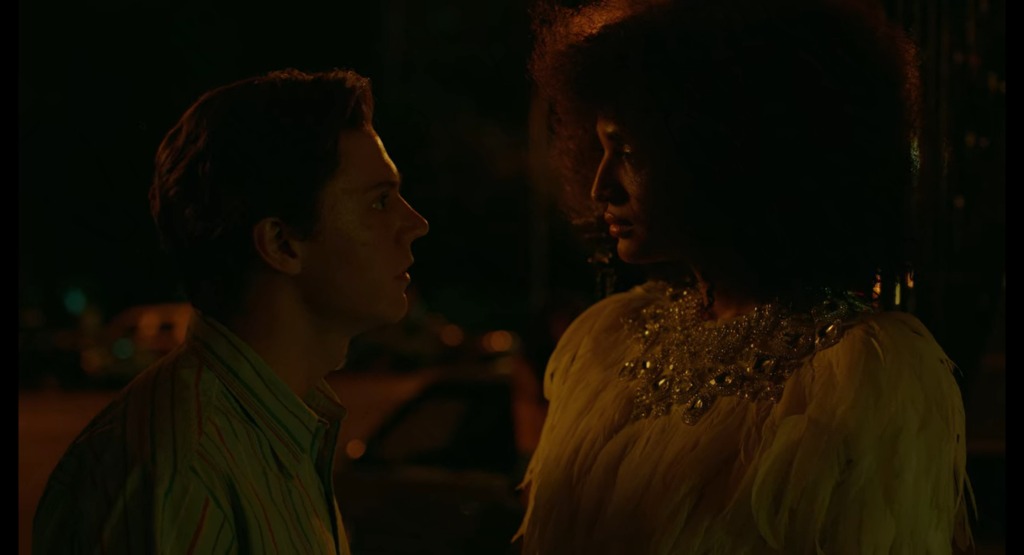A victorious step towards LGBTQ+ representation in television, FX’s American drama series Pose features the largest cast of transgender actors in scripted television history. The struggles of transgender people are finally being told on the screen decades after the 1980s setting of the show through New York’s underground ball culture. By analyzing how Pose portrays the relationships between white cisgender male and Black transgender female characters throughout the first season, we argue that hegemonic masculinity — institutionalized favor of male power — is a direct cause of the fetishization and objectification of Black transgender women by white cisgender men and persists off the screen in American society today.
Stan Bowes and Angel: Mythical Norms of Gender and Passing

This image from the first episode of season 1 of Pose is a shot of the first time Stan Bowes, played by Evan Peters, met Angel, played by Indya Moore. Dressed in neutral toned formal attire for an interview he just came from at the Trump Tower, Angel is a sharp contrast from him as she dominates the image with her level gaze and pink wild, fluffy coat.
Stan checks many boxes off of Audre Lorde’s concept of mythical norms of gender, identities that seem to be normal in society that other identities get measured against. Lorde defines the mythical norm in America as white, thin, male, young, heterosexual, Christian, and financially secure (Lorde, 1984). As shown in the image, Angel does not come close to fitting this mythical identity. A black, transgender, and financially insecure woman, she relies on her appearance to feel accepted and earning cash as a sex worker to live. The term “passing” is used frequently throughout the show by Angel and refers to a transgender person’s ability to be correctly perceived as the gender they identify as and not as transgender (Lee, 2017). Because Stan is married and fulfills the mythical norm identity, he does not have to worry about his appearance to be accepted by society like Angel does. In the image, Angel performs the female gender by appearing as feminine as she possibly can to anyone who looks at her. Angel hopes that she can be accepted by society as a woman by fulfilling gender expectations like painting her fingernails and wearing makeup. Because of this, she is beautiful yet exotic as society deems her as an “other” for her race and gender identity, and Stan’s unsaid sexual desire for something exotic and different is what causes Angel, while he never directly acknowledges it in the show, to become his fetish.
Mr. Ford and Elektra Abundance: Love or Fetish?

In another cisgender and transgender relationship portrayed in Pose, Mr. Ford plays a vital role in Elektra’s life as he represents that of hegemonic masculinity: white, straight, cisgender, and in the upper class of NYC society. Unlike the LGBTQ+ community in the 80s that often struggled against discrimination, Mr. Ford was the complete opposite: being a white, rich man, he could have anything he could possibly desire. As a result, in exchange for sexual pleasure specifically from Elektra — a Black transgender woman — Mr. Ford provides her with an abundant allowance that keeps her living in relative luxury while he is gone for business affairs and travels. After maintaining a long-lasting sexual relationship of 10 years, Mr. Ford believes he needs Elektra’s genitalia to remain as is because he likes “the feeling of know that [he’s] getting away with something that no one else knows about” and therefore he simply “just wants it there.” As Reid explains, the act of chasing works “by reducing an individual’s gender identity to sexual fixation [and] doesn’t move beyond the purely physical realm” (Reid, 2017). When Elektra later goes through with surgery to remove her male genitalia, he immediately removes her from his life. His life seemingly carries on as normal due to his power, while Elektra becomes unable to afford rent and has to work as a sex worker for money. This exemplifies how Elektra was no more than a fetish for Mr. Ford despite claims of love between them.
The Male Gaze

After meeting Angel for the first time, Stan takes her to a private hotel room where this image takes place. His fetish for transgender women is supported by the concept of the cisgender, heterosexual male gaze theorized by Laura Mulvey. Mulvey studied how women have historically been positioned in shots as an object to be looked at (Mulvey, 1975). In this image, it is notable that the camera is placed slightly behind Angel’s back to highlight Stan’s downward gaze towards her genitalia. In this scene, Stan’s first request was for Angel to take her underwear off. Due to this request and his direct gaze, the part of Angel that prohibits her from being a full woman in society’s eyes, her male genitalia, is objectified due to his fetish. Stan’s actions emphasize a part of her that makes her foreign, exotic and the “other.” While their relationship continues throughout the season and they grow closer, his fetish for a part of her that ostracizes her from society perpetuates the differences between them.
This dehumanization of transgender women as sexual objects for white men exists off the screen as well. In an analysis of dating profiles of men looking for trans women, Hender Gercio found a pattern of people that said something along the lines of “I am not gay. I am not attracted to men, just to ladies with something extra between their legs” (Gercio, 2015). Gercio found that this allows men to still feel masculine and hold power in society, as they are just expanding what it means to be attracted to women, but he argues this is problematic because it’s a “hegemonic masculine practice of dissociating oneself from anything that may be thought of as ‘gay’” (Gercio, 2015). This concept is portrayed in Pose through Stan and Mr. Ford’s ability to have relationships with Angel and Elektra and still hold their high level of power in society.
A “Kept Woman”

The show accurately represents the struggles that many Black transgender women face, particularly through the character Angel: housing problems, transgender discrimination, and being a sex worker for income (James et al., 2017). Consequently, the audience sees Angel’s initial fondness towards the idea of being, in a sense, a “kept woman.” Knowing that Angel hopes she can one day have a place to call home, Stan, in return, makes an arrangement with her. To keep Angel on the side, he agrees to provide her with financial care, including an apartment in Manhattan, while equally maintaining his regular life at home with his wife and kids. Stan fetishizes Angel as he pursues her for her transsexuality but continues to keep their affair a secret and Angel to himself only rather than continuing her work as a sex worker. However, he is unable to leave the image of a happy upper-middle class, white, straight life in the suburbs with his wife — a white, straight, cisgendered woman — and their children.
Fetish

In an intimate scene shared between Stan and Angel, Angel expresses her confusion and distress towards Stan in an attempt to understand why Stan chose her specifically. In response, the audience sees that Stan, even at the age of 14, had been sexually aroused by a Playboy-type magazine cover called “She-Males.” Studies have shown new, different pornography in which “the object of desire is a male to the female transsexual body—prior to surgery, penis intact” (Zeavin, 2011). Although it is unclear whether Stan is attempting to fulfill a sexual desire through Angel, Stan continues to view Angel as an exotic object as she possesses different qualities in her body – that of feminine body parts with male genitalia. Melanie Klein claims that “sexual aim is always intertwined with sexual object and that this object, however it is represented in the mind, is crucial to the formation of the ego” (Zeavin, 2011). For Stan, he has formulated this sexual object since his teenage years and as a result, his ego has caused him to fetishize Angel as she serves to be the “other” woman in society.
Fantasy

It wasn’t until Stan experienced Angel’s life by going to a ball with her that he decided to end their relationship. This image portrays his clear discomfort in a place where, for presumably the first time, Angel’s identity empowers her and Stan is a minority. Surrounded by LGBTQ+ people at a ball where they feel most comfortable to express themselves, he almost immediately wants to leave. In a reversal of roles, Angel hides him in a corner to help him feel more comfortable so he would stay for her performance. After this scene, Stan realizes how he can never have a true relationship with Angel because of how different their worlds are. He saw that she is able to be truly herself despite society not accepting her for it, and he realized that he is the one who plays “dress up” because he fulfills societal expectations for white men and his actions perpetuate hegemonic masculinity, such as working for a job that praises him for cheating on his wife. At this point, he awakens from the fantasy he has been living in where his obsession with Angel and her world allowed him to indulge in an exotic life that he does not belong in, causing him to leave her and empty their shared apartment.
Moving On

After his wife becomes aware of his affair with Angel, Stan attempts to repair his marriage to no avail. Even more so, Stan’s mentor, Matt Bromley, sabotages his career after spotting signs of success in the workplace. By the last episode of the season, Stan asks for Angel to give their relationship another chance now that he has left his wife and family. He tries, yet again, to “rescue” her from her life at the ball, a culture and lifestyle that are too incomprehensible for him to understand. Stan attempts to place his need to protect and be breadwinner by projecting the traits of emphasized femininity upon Angel, including that of being passive and in need of protection. Unbeknownst to him, Angel has moved on and found a place to call home with a family that accepts her for who she is – the House of Evangelista. From the image alone, the audience can assume that Angel has outgrown him and his needs, seeking to heal her own wounds and tend to her personal needs. Angel no longer desires to be a kept woman because that is not who she is or ever was. Stan, however, has had the “American dream” image destroyed altogether. By partaking in this relationship, he placed his family and career on a life-line which inevitably collapsed on him.
Angel Deserves More

In an advertisement for the Pose FX Facebook page, FX wrote “Love should never make you feel like that. Doesn’t Angel deserve more? #PoseFX” While the post can be portrayed as Angel deserving a better boyfriend, it can also be viewed as arguing that transgender women deserve to be equal to white men in society. Angel’s quote in the image, “I wasn’t nothing until he decided to come home and play with me,” places emphasis on the “he decided” text with how it is bolder and larger than the rest of the quote. This draws attention to how Stan held the power in their relationship and is another illustration of hegemonic masculinity. By using the phrase “play with me,” Angel acknowledges that Stan objectified her and, due to his power over her, even controlled her feelings of self worth. This relationship combined with the attitudes of Mr. Ford towards Elekra paints a picture of a greater societal trend of how hegemonic masculinity allows White cisgender men to hold power over Black transgender women, the exotic “other” due to their race and gender identity, by placing the worth of the women onto their male genitalia to fulfill the man’s fetish while simultaneously prohibiting them to have more power in society.
The show Pose brings to light many issues faced by the LGBTQ+ community in the 1980s. This article analyzes Stan and, to an extent, Mr. Ford as they both represent powerful figures in society with fetishes for Black transgender women. Through various scenes in the show, the audience is made aware of the privilege that these white, cisgender, and upper-middle class men hold in society as they are able to experiment with their sexualities freely with relatively little repercussions in comparison to say, Angel and Elektra. On the other hand, the Black transgender women are often left feeling dehumanized into a mere sexual fantasy.
Works Cited
Gercio, H. (2015). Looking for that ‘special’ lady: exploring hegemonic masculinity in online dating profiles of trans-attracted men. [MA Thesis, Central European University].
James, S. E., Brown, C., & Wilson, I. (2017, September). 2015 U.S. Transgender Survey: Report on the Experiences of Black Respondents. Washington, DC and Dallas, TX: National Center for Transgender Equality, Black Trans Advocacy, & National Black Justice Coalition.
Lee, J.A. (2017, June 10). What Does “Passing” Mean within the Transgender Community? Retrieved June 29, 2020, from https://www.huffpost.com/entry/what-does-passing-mean-within-the-transgender-community_b_593b85e9e4b014ae8c69e099
Lorde, A. (1984). Excerpt from “Age, Race, Class, and Sex: Women Redefining Difference” by Audre Lorde (1984). Let Nobody Turn Us Around: Voices of Resistance, Reform, and Renewal; An African American Anthology, pp. 538-544. https://www.amistadresource.org/documents/document_09_03_030_lorde.pdf
Mulvey, L. (1975). Visual Pleasure and Narrative Cinema. Screen, pp. 6-18.
Reid, C. (2017, December 07). My Trans Identity Is Not A Fetish. Retrieved June 29, 2020, from https://www.huffpost.com/entry/my-trans-identity-is-not-a-fetish_b_9592986
Zeavin, L. (2011). Imagining the She/Male: Pornography and the Transsexualization of the Heterosexual Male: Psychoanalytic Reflections. Studies in Gender & Sexuality, 12(4), 282–287. https://doi-org.ezproxy.lib.utexas.edu/10.1080/15240657.2011.610238
